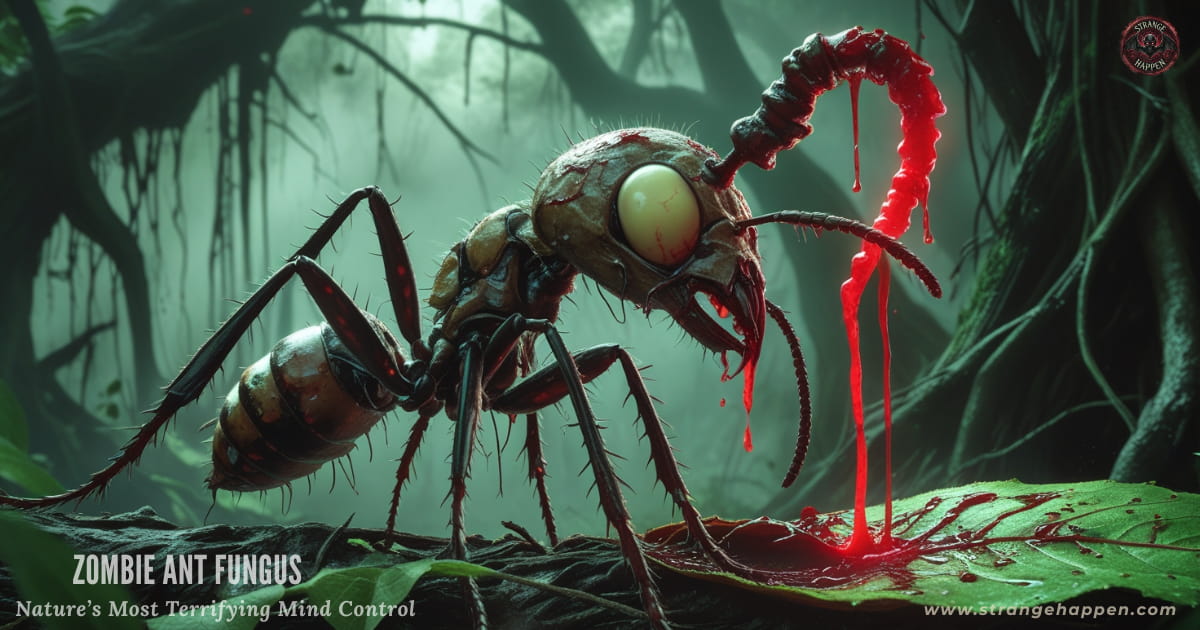Zombie Ant Fungus: Nature’s Most Terrifying Mind Control

What if a fungus could hijack an ant’s mind and turn it into a puppet? Welcome to one of the most chilling examples of strange happenings in the natural world. In lush tropical forests, a fungus known as Ophiocordyceps unilateralis, also called the zombie ant fungus, infects carpenter ants and compels them to climb, bite, and die—and then sprout a fungal stalk from their heads, releasing spores onto live ants below.
Is this a natural horror story or a biological marvel? Either way, it is a strange happening you won’t forget. But what scientists have uncovered over decades of research is far more bizarre than the viral headlines suggest. This mystery isn’t just a fungus controlling an insect. It’s a case study in mind control, evolutionary warfare, and environmental precision.
Get ready to learn about the zombie ant fungus’s effects, its causes, and what it can teach us about life’s limits.
Table of Contents
Where It Happens
Location
Ant zombie outbreaks occur mainly in pantropical forests—from the Amazon Basin to Southeast Asia, West Africa, and even parts of Oceania. The exact zones are often highly specific: damp, shaded patches of rainforest with a steady 90% humidity and temperatures around 20–25°C (68–77°F).
This is important. Ophiocordyceps unilateralis, the zombie ant fungus, doesn’t thrive just anywhere. It requires near-perfect ecological conditions. That precision is what makes these strange happenings feel almost orchestrated.
In fact, fungal infection maps often align with canopy gaps—areas where the sunlight allows just enough warmth and moisture for spore viability.
“It’s not random. The fungus is an ecological sniper.” “Dr. David Hughes, a parasitic behavior expert at Penn State, explains that the fungus targets its environment with uncanny accuracy—not unlike a biological marksman.”
The Infection Process
How the Infection Happens
It begins when a wandering carpenter ant brushes against a spore cluster. Once the spore lands on the ant, it begins to grow—releasing enzymes that gradually break down the insect’s tough outer shell. Thread-like structures called hyphae bore through the body wall, eventually invading the hemocoel (insect bloodstream).
The zombie ant fungus avoids the ant’s brain—a shocking revelation. Instead of mind control through brain invasion, it forms an intricate network around muscle fibers and neural ganglia, essentially “remote-controlling” movement.
Incredibly, the ant’s brain remains intact throughout much of the zombification.
Why It Infects
From the fungus’s perspective, the ant is merely a delivery mechanism. By guiding the ant to die in a precise microclimate, usually on the underside of a north-facing leaf, it ensures optimal temperature and spore dispersal.
This is not just parasitism—it’s strategic manipulation. The behavior benefits only the zombie ant fungus, at the total cost of the host. And it evolved to work this way through countless evolutionary skirmishes.
What Disease It Causes
Although not a disease by medical standards, the infection causes a total systemic fungal infestation. Symptoms in ants include:
- Neuromuscular deterioration
- Hyper-convulsions and disorientation
- Isolation behavior (leaving the colony)
- Erratic climbing
- Mandibular necrosis and rigid locking
Researchers consider the zombie ant fungus one of the most extreme examples of a behavior-modifying parasite. It has no known cure in insects.
Timeline of the Takeover
Duration and Phases
The full zombification process caused by the zombie ant fungus lasts around 21 days, with 5 key stages:
- Spore contact and cuticle breach
- Internal proliferation and immune suppression
- Behavioral alteration and summit disease
- Death grip and post-mortem fungal fruiting
- Sporulation and environmental re-entry
After the ant secures itself to a leaf, death typically follows within a day. By the second day, a fungal stalk pierces through its head. Within 72 hours, the air becomes loaded with spores, ready to infect the next victim.
Symptoms and Behavioral Changes
Some ants experience seizures or leg twitching. They often wander aimlessly before climbing. As the zombie ant fungus takes over motor control, the ant stops cleaning itself and separates from the colony—a programmed exile to prevent others from helping or stopping it.
Many infected ants clamp onto the same height and compass direction. That’s not random. It’s the optimal spore trajectory.
Life and Death of a Zombie Ant
Life of a Zombie Ant
For the last 72 hours of its life, the infected ant exists in a near-hypnotic state. Its consciousness is still present but overridden by neuromuscular input from the fungal network. It cannot resist the command to climb. It cannot choose its final resting place.
After death, fungal tissues continue to reinforce the exoskeleton to maintain structural integrity. The emerging stalk then bursts through the back of the head, supported by fungal cement secreted from the ant’s joints.
Challenges Faced by the Fungus
Even this mind-controlling fungus isn’t invincible—it faces threats from predators, rival microbes, and even other fungi.
- Ant corpse removal: Healthy ants drag infected corpses far from the colony.
- Predators: Spiders, birds, and even parasitic wasps feed on infected ants.
- Mycoparasites: Fungi like hyperparasite species attack Ophiocordyceps, neutralizing its spores.
That means zombification must happen fast. Delay equals death—for the fungus.
Can It Infect Humans?
Danger Level for Humans
Despite its fictional fame in shows like The Last of Us, the zombie ant fungus is not dangerous to humans. It is species-specific. Our immune system, body heat, and biology are incompatible with its needs.
However, increasing resistance to antifungal treatments—combined with global warming—is raising new concerns among scientists. Other fungi (Candida auris, Aspergillus) have jumped species. Some scientists are monitoring Cordyceps strains in warmer regions for mutation patterns.
What if it did infect humans?
In a fictional scenario, symptoms might include:
- Muscular twitching and climbing urges
- Photophobia (light aversion)
- Compulsive behavior and social isolation
- Nervous system disruption
Countermeasures would involve antifungal drugs like amphotericin B, plus quarantine and full-spectrum scanning. Still, experts agree this remains extremely unlikely.
How to Prevent Infection (in Insects)
- Colony hygiene: Healthy ants recognize infected members and eject them.
- Antifungal grooming: Ants clean one another using saliva packed with natural antimicrobial compounds.
- Trail avoidance: Foraging routes change when infected corpses are found.
These tactics form a kind of collective immune system—a defense known as social immunity.
Evolutionary Secrets & Lesser-Known Facts
Shocking Discoveries
- Fossils from 48 million years ago show ants with the same death grip.
- Zombie-ant behavior evolved independently in multiple fungal species—convergent evolution.
- In lab conditions, the zombie ant fungus fails to reproduce unless its host dies in the wild.
- Some ants evolved behavioral immunity: they avoid tall vegetation during outbreaks.
- Fungal genes encode enzymes that mimic insect hormones—chemical puppeteering.
Researchers found that infected ants often die just before sunrise. Why? Temperature, humidity, and light conditions make it the perfect time for sporulation.
Reflection: Why It Matters
The zombie ant fungus is more than a grotesque oddity. It reveals how evolution creates complexity not through intelligence, but through raw, iterative efficiency. The fungus doesn’t “know” what it does—but it’s evolved to exploit behavior with precision that rivals human technology.
These strange happenings show us just how interconnected life really is. When a fungus can control an insect’s body like a marionette, we have to ask: What else in nature bends free will?
But the zombie ant is not alone. From spiders to beetles, other species are falling victim to equally eerie forms of parasitic manipulation.
👉 Are you curious about what happens when beetles fall under a similar spell? Dive into the zombie beetle mystery.
🧠 Conclusion: When Nature Rewrites the Rules
The zombie ant fungus is more than a grotesque oddity—it’s a chilling reminder of how evolution can master behavior. But it’s not alone. Other parasites, like those behind zombie beetles, are rewriting the rules of life in equally eerie ways.
These strange happenings remind us that in nature, control doesn’t always come from intelligence—sometimes, it comes from something much smaller and far more sinister.
What if free will is not as absolute as we believe? What if behavior can be engineered by nature itself? These infections show that evolution doesn’t just shape bodies—it can hijack decisions.
So what else is out there, silently pulling the strings?
🧠 Curious for more? Dive deeper into the unexplained, the eerie, and the extraordinary—only on Strange Happenings. Your next mystery awaits.




